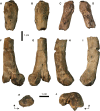An avian femur from the Late Cretaceous of Vega Island, Antarctic Peninsula: removing the record of cursorial landbirds from the Mesozoic of Antarctica
- PMID: 31333904
- PMCID: PMC6626523
- DOI: 10.7717/peerj.7231
An avian femur from the Late Cretaceous of Vega Island, Antarctic Peninsula: removing the record of cursorial landbirds from the Mesozoic of Antarctica
Abstract
In 2006, a partial avian femur (South Dakota School of Mines and Technology (SDSM) 78247) from the Upper Cretaceous (Maastrichtian) Sandwich Bluff Member of the López de Bertodano Formation of Sandwich Bluff on Vega Island of the northern Antarctic Peninsula was briefly reported as that of a cariamiform-a clade that includes extant and volant South American species and many extinct flightless and cursorial species. Although other authors have since rejected this taxonomic assignment, SDSM 78247 had never been the subject of a detailed description, hindering a definitive assessment of its affinities. Here we provide the first comprehensive description, illustration, and comparative study of this specimen. Comparison of characters that may be assessed in this femur with those of avian taxa scored in published character matrices refutes the inclusion of SDSM 78247 within Cariamiformes, instead supporting its assignment to a new, as-yet unnamed large-bodied species within the genus Vegavis, and therefore its referral to a clade of semiaquatic anseriforms. Important character states diagnostic of Vegavis + Polarornis include strong craniocaudal bowing of the femoral shaft, the presence of a distinct fossa just proximal to the fibular trochlea, and the broad and flat shape of the patellar sulcus. Referral to Vegavis is based on the presence of a distinctive proximocaudal fossa and distolateral scar. This genus was previously known only from Vegavis iaai, a smaller-bodied taxon from the same locality and stratigraphic unit. Our reassignment of SDSM 78247 to Vegavis sp. removes the record of cariamiform landbirds from the Antarctic Cretaceous.
Keywords: Anseriformes; Antarctica; Bird; Cariamiformes; Cretaceous; Femur; López de Bertodano Formation; Maastrichtian; Vega Island; Vegavis.
Conflict of interest statement
Julia A. Clarke is an Academic Editor for PeerJ.
Figures




References
-
- Acosta Hospitaleche C, Gelfo JN. New Antarctic findings of Upper Cretaceous and lower Eocene loons (Aves: Gaviiformes) Annales de Paléontologie. 2015;101:315–324.
-
- Alvarenga HMF, Hofling E. Systematic revision of the Phorusrhacidae (Aves: Ralliformes) Papéis Avulsos de Zoologia. 2003;43:55–91.
-
- Case J, Reguero M, Martin J, Cordes-Person A. A cursorial bird from the Maastrichtian of Antarctica. Journal of Vertebrate Paleontology. 2006;26(3 supp):48A.
LinkOut - more resources
Full Text Sources

